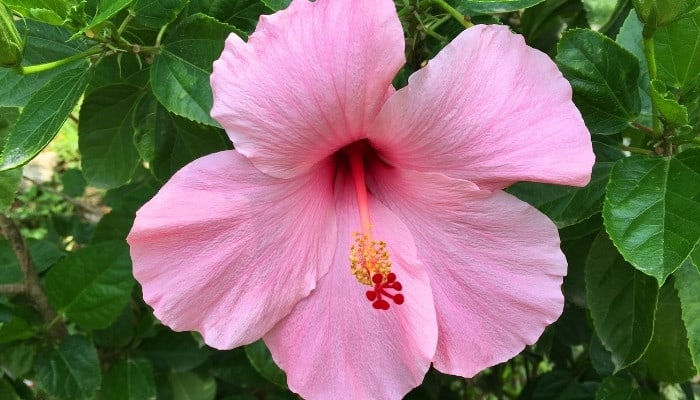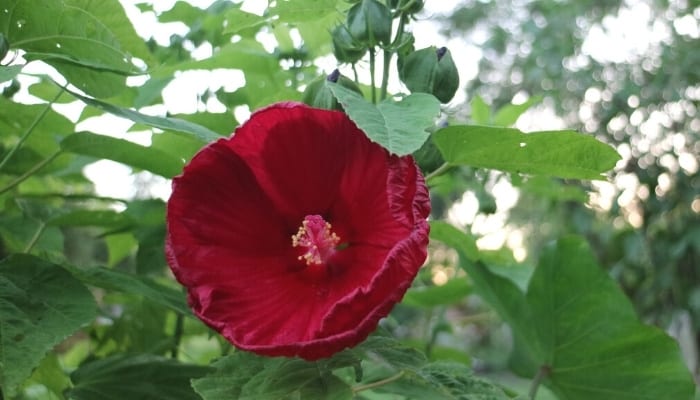The species of hibiscus known as Hardy hibiscus is highly favored for its aesthetic appeal and is often chosen as a lovely addition to one’s garden.
This non-tropical plant can withstand strong winters and is easy to care for. It also has lovely flowers that attract hummingbirds and butterflies.
If your hardy hibiscus hasn’t bloomed in a while, you may be wondering if it’s dead or just dormant.
Is my hibiscus dead? It’s easy to mistake the seasonal change of hardy hibiscus for death. Hardy hibiscus plants usually shed their leaves and flowers during winter and bloom again in spring. To be sure the plant is still alive, check for green under the bark or gently bend a young twig to test for pliability.
If you’ve ever wondered how to tell the difference between a dead and dormant hardy hibiscus, this article will help you!
What’s more, if you frequently confuse a hardy hibiscus with a tropical hibiscus, you can learn more below. So let’s get started!
How To Tell if Hibiscus Is Dead
It can be tricky to tell if your hibiscus is dead or simply sleeping through the winter. Don’t worry, hardy hibiscus is notorious for taking forever to come out of its dormancy!
With just a few looks here and there, you can easily check for signs of life in your hardy hibiscus.
1. Check for Green Under the Bark
Although hardy hibiscus plants can survive harsh winters, some still confuse its dormancy for death.
That’s because during the cold season the hibiscus loses the beautiful green leaves that usually adorn their branches.
Check under the bark of your hardy hibiscus to see if it survived the winter. If possible, use your fingernails or a garden knife to gently scrape a tiny portion of the top layer of the bark.
If you find it green and moist on the inside, congratulations! In the coming spring, your hardy hibiscus will bloom. Sadly, if it’s brown and dry inside with no colors of life, then it’s probably dead.
2. Gently Bend Branches To Test Pliability
Your plant’s branch flexibility can tell you a lot about its health. When you bend any branch or stem of a dead plant, chances are that it’ll snap in your fingers.
However, if your hibiscus hardy is still alive, it should be flexible. After being bent, you’ll find that it bounces back easily.
3. Examine Leaves for Signs of Life
The color and texture of the hibiscus leaves can tell you if it’s alive or dead. Don’t worry if the leaves are yellow as that is normal.
They may just need more sunlight or more nutrients.
If you see brown leaves still stuck to the branches of your hardy hibiscus, it may be dead.
A living plant should naturally shed any dead leaves on its branches. However once a plant is dead, it’ll no longer be able to get rid of those leaves.
4. Cut Off Dead Portions & Wait for New Growth
Hardy hibiscus plants are perennials, so they don’t grow from the stalks; they regrow from their roots.
This is an essential piece of information as you’ll need to actually look beneath the seemingly dead branches to see if there are any growing buds down there.
To make sure there’s room for new growth, sharpen the garden shears and start cutting all excess around the growing buds.
Pruning your hibiscus is a great way to maintain its size and desired shape while also making sure there’s good air circulation within the plant’s branches.
5. Wait To See if Plant Awakens in Spring
Hardy hibiscus plants can fool you into thinking their winter nap is going to last an eternity.
However, as the weather starts to warm up with the arrival of spring, you’ll notice new buds on the ground blooming and leaves shooting from branches.
It’s crucial to be patient with your hardy hibiscus and make sure they’re still alive until they bloom by following the previous tricks.
Tropical vs. Hardy Hibiscus
Although tropical and hardy hibiscus flowers are almost indistinguishable, the most distinct difference between those plants is their tolerance for harsh winters.
Tropical hibiscus can’t survive in winter and only tolerates small periods of cold. According to the USDA Plant Hardiness Zone Map, tropical hibiscus can’t survive in zones lower than Zone 9.
They flourish best in areas with a warm climate and can bloom from early spring to late fall.
On the other hand, hardy hibiscus plants will be dormant in winter with no lovely flowers decorating them, but they’ll survive in freezing temperatures.
Hardy hibiscus tolerates harsh winters as far as USDA plant Hardiness Zone 4.
There’s a noticeable difference in the hardy and tropical hibiscus leaves as well. Tropical hibiscus plants have glossy, deep-green leaves.
On the other hand, hardy hibiscus has heart-shaped leaves with jagged edges that are duller in color.
Dormant Hibiscus
You might have a leafless plant sitting in the garden and wonder, “Is my hardy Hibiscus dead or dormant?”
Hardy hibiscus plants can survive a harsh winter, but the flowers and leaves themselves won’t. The plant will look dead at the start of the frost.
The leaves will first turn yellow and brown, then fall off. By that time, there won’t be any blooming flowers in sight.
In Hardiness Zones 4 through 9, a hardy hibiscus plant will typically begin dormancy in the fall and end at the start of spring.
During its dormancy, you can protect your hardy hibiscus by packing mulch around the base. It’ll help to ward off the freeze and protect the plant’s roots.
You can also cover the plant to protect it from snow or falling debris during winter.
Dormant hardy hibiscus doesn’t need watering as much during this period and may only need some water once a week or when the soil is dry.
Unlike the tropical hibiscus, it’s necessary for a hardy hibiscus to undergo dormancy. This period allows the plant to rest during winter.
After the hardy hibiscus has rested, it’ll produce beautiful blooms again as the temperatures start to rise.
For tips and advice on keeping your Hibiscus blooming, check out our guide: “How to Keep Hibiscus Blooming – 11 Care Tips For Lasting Flowers.” It’s full of useful information to help your Hibiscus thrive.

How to Revive a Dying Hibiscus
To bring life back into your dying hibiscus, you have to first make sure the soil isn’t overwatered but rather just lightly moist.
Spray the leaves, and keep your hibiscus in the sunlight for at least five hours a day.
You can use your shears to cut off any branches without buds to ensure that the rest of your plant thrives faster. Doing this will encourage new buds to grow on your hibiscus bush.
Related Questions:
How To Tell if Hibiscus Is Hardy or Tropical?
The simplest way to differentiate a hardy hibiscus from a tropical is to look at their leaves. If the leaf is heart shaped with a jagged edge, you’re probably looking at a hardy hibiscus.
On the other hand, a tropical hibiscus has glossy leaves that are a deeper green color than hardy hibiscus.
Do Hibiscus Lose Leaves in the Winter?
Yes, they do! If you have a hardy hibiscus, it’ll start shedding its leaves and flower buds during the winter season.
However, if you have a tropical hibiscus, this could probably mean that it’s dying because they don’t tolerate harsh winters.
Final Thoughts
Now that you’ve reached the end, you can easily figure out whether your hardy hibiscus is dead or dormant by simply taking a closer look at your plant.
In the end, a hardy hibiscus is called hardy for a reason! It can withstand the freezing winter and come back beautifully next spring. So don’t let the withering leaves or empty branches fool you!
Hopefully, this information has been helpful to you and answered your questions on how to tell if your hibiscus is dead or dormant.
Sources:

